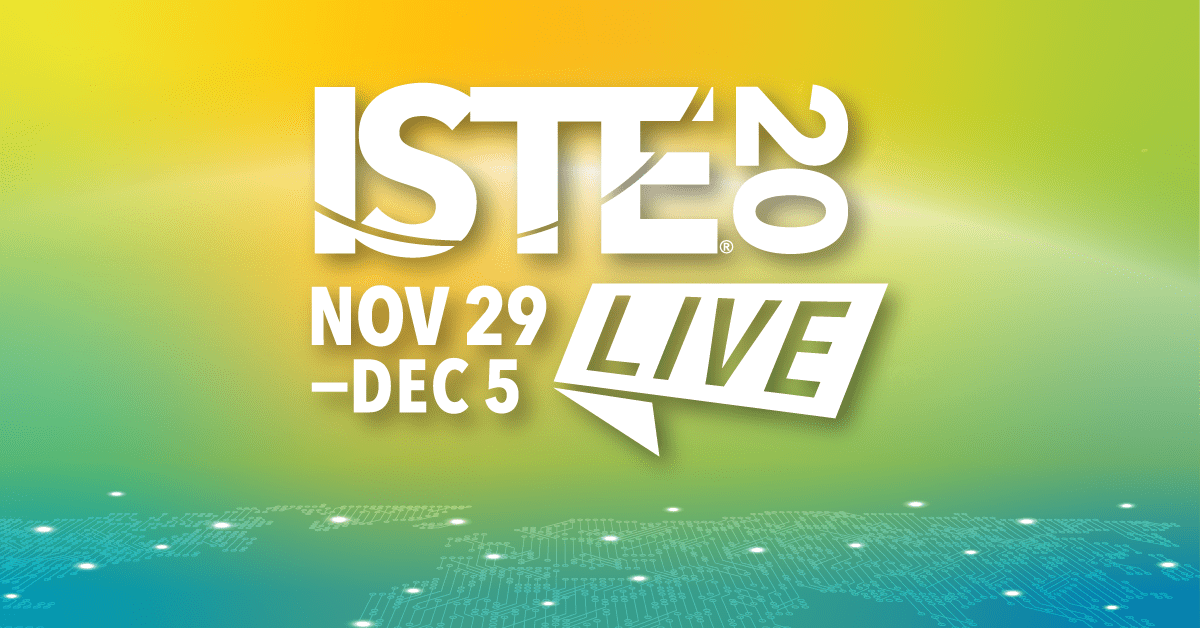Distance, Online & Blended Learning – Part 2

*This post has been written as part of my professional growth plan through my #ISTE20 scholarship.
Reimagine Your Classroom: ISTE’s Top Tips, Tricks & Tools for Online learning
Presenters: Brian Huff, Liz Lee, & Dr. Joseph South
Overview: “When schools began shifting to virtual learning last spring, ISTE quickly pivoted to develop relevant, bite-size, engaging professional development focused on online and blended learning. Join this session to learn some of ISTE’s top strategies for online teaching, including how to create community, design instruction, provide feedback, and ensure equity and inclusion in online learning environments. You will also hear from a district leader who incorporated ISTE’s strategies into their district’s professional development over the summer — and what the outcomes were. Finally, learn more about ISTE U’s online courses that will guide you deeper into these topics.”
Main Takeaways
- Rowland Unified School District
- teachers are trying lots of things but are sometimes lacking the understanding of how to use these tools in a pedagogically sound manner during distance delivery
- active feedback from students and teachers helps build a better distance learning network
- a consistent communication platform between schools and families is key
- how do we keep students engaged?
- how we support social-emotional needs?
- how do we check for understanding?
- how do we give feedback in a meaningful way?
- ISTE’s 4 Foundations for Online Teaching
- 1. Equity & Inclusion
- digital divide
- demographics such as students with special learning needs, early elementary, communities without connectivity
- recognize biases & student identity
- select tools that can be used with all students
- scaffold lessons
- 2. Creating Community
- establish a communication plan (synchronous & asynchronous)
- foster collaboration between students
- still bring personality, fun, and personal quirks into online space (ex: bitmojis)
- 3. Designing Instruction
- support student agency over pace, path, time and place
- select the right tools for your goals, students, platforms
- take into account cognitive load by chunking information and increased use of multi-media
- 4. Feedback & Assessment
- leverage formative assessment
- meaningful & timely feedback (written, peer, audio, video)
- effective summative assessments through performance-based tasks
- 1. Equity & Inclusion
- PD from ISTE U
- There is no one course that is going to solve how to teach during a pandemic
- The goal is to provide foundational skills and the understanding of how to work to meet students where they are at while they are away from our buildings
Further Resources
- ISTE U Academy & Microcourses
- ISTE U Online Teaching Academy
- Learn more about the 4 pillars in this choice board
Examining the Role of Learner Presence Across Online, Blended & Traditional Courses
Presenters: Catherine Bacos, Dr. Elhan Arabi, Karen Grove, Elizabeth Barrie, & Brian Bullock
Overview: “The authors will examine the role of learner presence as an emerging construct in the Community of Inquiry framework. Learner presence will be measured as the metacognitive and motivational traits and activities of preservice and in-service teachers in online, blended and traditional courses.“
Main Takeaways
- Community of Inquiry
- Learner Presence has both metacognitive and motivational traits that take into account self-regulation and self-efficacy
- What are the relationships among the 4 constructs in the enhanced CoI model?
- teaching, social, cognitive, and learning presence are all strongly correlated
- What are the differences in the 4 CoI constructs between students in online and blended courses?
- social presence was significantly higher in blended compared to online
- there is no statistical differences in the remaining 3 constructs
- To what extent do the constructs of learning presence, course format, and student attitudes toward e-learning influence the CoI constructs?
- the higher the participants level of motivation the higher the level of teaching presence
- higher levels of online preference indicated higher levels of social presence
- high levels of student learning presence and preference indicate higher levels of cognitive presence
- Compared to online formats: blended formats have higher social presence but lower learning presence
- social presence needs to be established earlier; especially online
- self-regulation is required for success in blended format
Further Resources
Teach Using Live Video: best practices from 12 years in the field
Presenters: Courtney Dayhuff, Jacquelin Fink, Seth Fleischauer, & Travis Moyer
Overview: “Explore best practices for connecting students with international peers, teachers, experts and field trips. Experience hands-on, interactive videoconferencing while presenters address the requirements for effective videophonic education: lively and effective distance learning teachers, interactive blended learning, engaging aesthetics and collaborative classroom teachers.”
Main Takeaways
- Can connect students with peers, teachers, guest speakers, experts in the field
- T.I.T.A.C. model
- Teacher: engaging, humour, enthusiastic, inclusion of solid lesson planning & pedagogy, effective pace & speech patterns
- Interaction: balance teacher “show” with student input, practice global citizenship skills & reinforce 21st century skills
- Technology: driven by learning goals, internalize it so it can be seamless, make sure all stakeholders are on the same page about the use of tech, don’t just use technology as a substitute
- Aesthetics: camera ready (both audio and visual), well framed and well lit, use of camera and voice to make a dynamic experience, inclusion of digital resources
- Collaboration: open communication between all stakeholders (teachers, parents, learners, support roles), clearly established roles & procedures, in-room adults are placed in charge of behaviour, provide a backchannel to discuss issues, ask questions, etc
Further Resources
- TITAC Method: Best Practices for Online Teaching blog post
- Favourite Tools for Learning Online blog post
The next learning topic on my professional growth plan is “Coaching & Mentoring”.
